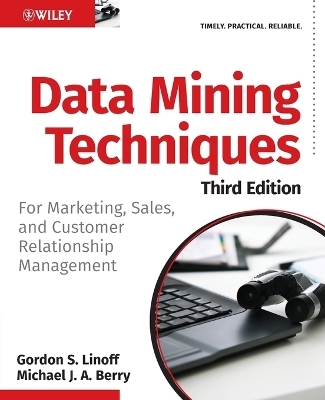
Data Mining Techniques
John Wiley & Sons Ltd (Verlag)
978-0-470-65093-6 (ISBN)
When Berry and Linoff wrote the first edition of Data Mining Techniques in the late 1990s, data mining was just starting to move out of the lab and into the office and has since grown to become an indispensable tool of modern business. This new edition - more than 50% new and revised - is a significant update from the previous one, and shows you how to harness the newest data mining methods and techniques to solve common business problems. The duo of unparalleled authors share invaluable advice for improving response rates to direct marketing campaigns, identifying new customer segments, and estimating credit risk. In addition, they cover more advanced topics such as preparing data for analysis and creating the necessary infrastructure for data mining at your company.
- Features significant updates since the previous edition and updates you on best practices for using data mining methods and techniques for solving common business problems
- Covers a new data mining technique in every chapter along with clear, concise explanations on how to apply each technique immediately
- Touches on core data mining techniques, including decision trees, neural networks, collaborative filtering, association rules, link analysis, survival analysis, and more
- Provides best practices for performing data mining using simple tools such as Excel
Data Mining Techniques, Third Edition covers a new data mining technique with each successive chapter and then demonstrates how you can apply that technique for improved marketing, sales, and customer support to get immediate results.
GORDON S. LINOFF and MICHAEL J. A. BERRY are the founders of Data Miners, Inc., a consultancy specializing in data mining. They have jointly authored two of the leading data mining titles in the field, Data Mining Techniques and Mastering Data Mining (both from Wiley). They each have decades of experience applying data mining techniques to business problems in marketing and customer relationship management.
Introduction
Chapter 1: What Is Data Mining and Why Do It?
Chapter 2: Data Mining Applications in Marketing and Customer Relationship Management.
Chapter 3: The Data Mining Process.
Chapter 4: Statistics 101: What You Should Know About Data.
Chapter 5: Descriptions and Prediction: Profiling and Predictive Modeling.
Chapter 6: Data Mining Using Classic Statistical Techniques.
Chapter 7: Decision Trees.
Chapter 8: Artifi cial Neural Networks.
Chapter 9: Nearest Neighbor Approaches: Memory-Based Reasoning and Collaborative Filtering.
Chapter 10: Knowing When to Worry: Using Survival Analysis to Understand Customers.
Chapter 11: Genetic Algorithms and Swarm Intelligence.
Chapter 12: Tell Me Something New: Pattern Discovery and Data Mining.
Chapter 13: Finding Islands of Similarity: Automatic Cluster Detection.
Chapter 14: Alternative Approaches to Cluster Detection.
Chapter 15: Market Basket Analysis and Association Rules.
Chapter 16: Link Analysis.
Chapter 17: Data Warehousing, OLAP, Analytic Sandboxes, and Data Mining.
Chapter 18: Building Customer Signatures.
Chapter 19: Derived Variables: Making the Data Mean More.
Chapter 20: Too Much of a Good Thing? Techniques for Reducing the Number of Variables.
Chapter 21: Listen Carefully to What Your Customers Say: Text Mining.
Index
| Erscheint lt. Verlag | 1.4.2011 |
|---|---|
| Verlagsort | Indianapolis |
| Sprache | englisch |
| Maße | 188 x 231 mm |
| Gewicht | 1274 g |
| Einbandart | Paperback |
| Themenwelt | Informatik ► Datenbanken ► Data Warehouse / Data Mining |
| Wirtschaft ► Betriebswirtschaft / Management ► Marketing / Vertrieb | |
| Schlagworte | Data Mining |
| ISBN-10 | 0-470-65093-1 / 0470650931 |
| ISBN-13 | 978-0-470-65093-6 / 9780470650936 |
| Zustand | Neuware |
| Informationen gemäß Produktsicherheitsverordnung (GPSR) | |
| Haben Sie eine Frage zum Produkt? |
aus dem Bereich


